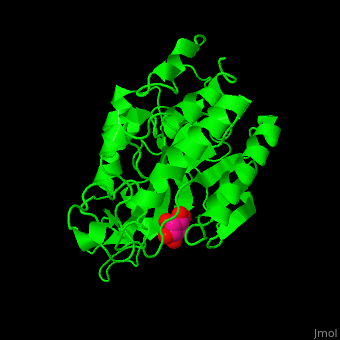Phospholipase C
From Proteopedia
| |||||||||||
3D structures of phospholipase C
Updated on 28-August-2023
References
- ↑ Barr AJ, Marjoram R, Xu J, Snyderman R. Phospholipase C-beta 2 interacts with mitogen-activated protein kinase kinase 3. Biochem Biophys Res Commun. 2002 Apr 26;293(1):647-52. PMID:12054652 doi:http://dx.doi.org/10.1016/S0006-291X(02)00259-0
- ↑ Yasuoka A, Aihara Y, Matsumoto I, Abe K. Phospholipase C-beta 2 as a mammalian taste signaling marker is expressed in the multiple gustatory tissues of medaka fish, Oryzias latipes. Mech Dev. 2004 Jul;121(7-8):985-9. PMID:15210203 doi:http://dx.doi.org/10.1016/j.mod.2004.03.009
- ↑ Ye K, Aghdasi B, Luo HR, Moriarity JL, Wu FY, Hong JJ, Hurt KJ, Bae SS, Suh PG, Snyder SH. Phospholipase C gamma 1 is a physiological guanine nucleotide exchange factor for the nuclear GTPase PIKE. Nature. 2002 Jan 31;415(6871):541-4. PMID:11823862 doi:http://dx.doi.org/10.1038/415541a
- ↑ Mortara RA, Minelli LM, Vandekerckhove F, Nussenzweig V, Ramalho-Pinto FJ. Phosphatidylinositol-specific phospholipase C (PI-PLC) cleavage of GPI-anchored surface molecules of Trypanosoma cruzi triggers in vitro morphological reorganization of trypomastigotes. J Eukaryot Microbiol. 2001 Jan-Feb;48(1):27-37. PMID:11249190
- ↑ Sala G, Dituri F, Raimondi C, Previdi S, Maffucci T, Mazzoletti M, Rossi C, Iezzi M, Lattanzio R, Piantelli M, Iacobelli S, Broggini M, Falasca M. Phospholipase Cgamma1 is required for metastasis development and progression. Cancer Res. 2008 Dec 15;68(24):10187-96. doi: 10.1158/0008-5472.CAN-08-1181. PMID:19074886 doi:http://dx.doi.org/10.1158/0008-5472.CAN-08-1181
- ↑ Mir H, Khan S, Arif MS, Ali G, Wali A, Ansar M, Ahmad W. Mutations in the gene phospholipase C, delta-1 (PLCD1) underlying hereditary leukonychia. Eur J Dermatol. 2012 Nov-Dec;22(6):736-9. doi: 10.1684/ejd.2012.1852. PMID:23149345 doi:http://dx.doi.org/10.1684/ejd.2012.1852
- ↑ . Editorial: The glue-ear syndrome. Lancet. 1975 Aug 30;2(7931):397-8. PMID:51196
- ↑ Heinz DW, Ryan M, Bullock TL, Griffith OH. Crystal structure of the phosphatidylinositol-specific phospholipase C from Bacillus cereus in complex with myo-inositol. EMBO J. 1995 Aug 15;14(16):3855-63. PMID:7664726
Proteopedia Page Contributors and Editors (what is this?)
Michal Harel, Alexander Berchansky, Joel L. Sussman, Jaime Prilusky

